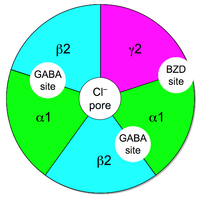
Photo from wikipedia
A regulator of inhibitory neurotransmission is essential for benzodiazepine actions Fast synaptic inhibition in the central nervous system is achieved by the inhibitory neurotransmitter γ-aminobutyric acid (GABA) type A (GABAA)… Click to show full abstract
A regulator of inhibitory neurotransmission is essential for benzodiazepine actions Fast synaptic inhibition in the central nervous system is achieved by the inhibitory neurotransmitter γ-aminobutyric acid (GABA) type A (GABAA) receptors. These receptors are postsynaptic pentameric complexes that form a central pore that is permeable to chloride ions. GABA typically increases chloride influx, which results in hyperpolarization of the postsynaptic membrane, rendering it less excitable. GABAA receptors modulate vigilance, emotions, cognition, and muscle tension, and they are the targets of anxiety-reducing and sedative-hypnotic benzodiazepines and some general anesthetics, such as propofol. These drugs increase GABA-induced chloride currents (1). On page 246 of this issue, Han et al. (2) describe the identification of an auxiliary protein that interacts with GABAA receptors and modulates their response to benzodiazepines. These findings have considerable implications for understanding benzodiazepine action because they redefine the components minimally required to support their actions.
Journal Title: Science
Year Published: 2019
Link to full text (if available)
Share on Social Media: Sign Up to like & get
recommendations!